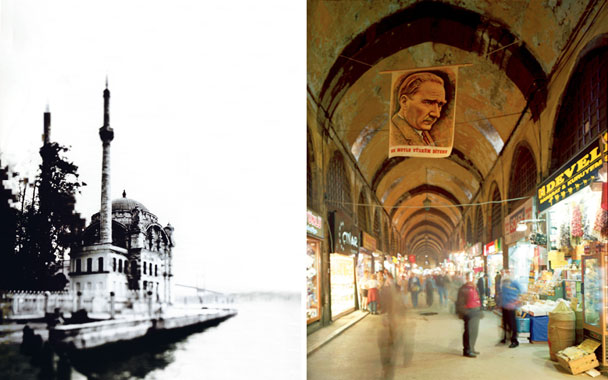Normally a sane driver, at least by Turkish standards, Ihsan abruptly jerked the wheel to the right and swerved across three lanes of traffic on the busy Bosporus highway. I was seized by the sudden, horrible fear that I was about to die, not for love or patriotism or even money, but for a kebab. And a trash kebab, at that.
It’s not as if we hadn’t already had kebabs. Lots of kebabs. Really great kebabs. And even this skewered plenitude was only the beginning of what we had eaten on the streets of this always surprising city. In fact, the variety and quality of the food there echoes the magnificence of Istanbul’s not-so-distant Ottoman past, when eating was such an obsession that many of the 1,300 cooks in Topkapi Palace spent their entire professional lives perfecting a single dish.
Fittingly, it is in the warren of narrow streets outside the mammoth Grand Bazaar, in the historic Sultanahmet district, that Istanbul’s street-food scene reaches its zenith. That very afternoon, wandering among the bustling crowds dressed in everything from full-length black robes to business suits, Ihsan and I had stood in a long, snaking line outside a minuscule shop to take away the best doner kebab I have ever tasted. I thought I was satisfied, but about 20 feet later Ihsan stopped at a glass-topped cart for a stuffed mussel, nested in its shell over a mound of subtly spiced rice. As I ate my third, I noticed a woman sitting on the street behind me selling something I’d never seen before: long, translucent, bumpy, sausagelike shapes. They turned out to be an Ottoman sweet—ropes made of paper-thin grape “leather” that had been thickly stuffed with toasted walnut halves.
We kept strolling, meandering, sampling. We tried kokoreç, a pleasingly fatty snack of lamb intestines fashioned into coils, grilled over charcoal, then chopped up and seasoned with dried oregano and the ever-present Maras pepper. Next came a sandwich of ground lamb cooked on a wide, round, black metal griddle. In one narrow alley, we came upon my absolute favorite, çig kofte, the hand-fashioned “cigars” of heavily spiced raw ground veal served on a leaf of romaine lettuce with a squeeze of lemon and a scallion. Even after that, I couldn’t resist a piece of pide bread simply grilled and skimmed with butter.
When we finally emerged onto a main artery near the Egyptian Spice Bazaar, I couldn’t even look at the grilled corn and chestnuts on offer. But Ihsan said, “Well, it’s after nine. The cöp şiş stand should be opening about now,” and we took off on that fateful drive to the Asian side.
As it turned out, Istanbul’s drivers are unusually adept at avoidance tactics, and we made it safely to the curbside, where Ihsan hopped out of the car to embrace Ercan, the tall, thin Turk presiding over the brazier. As they laughed and hugged, I inspected the skewers laid out over the glowing coals: There were cubes of lamb interspersed with small chunks of mutton fat, spicy sucuk sausage alternating with aged kaşar cheese, long skewers of diminutive lamb livers.
This being Istanbul, where kebabs are practically a religion, this variety had its own very specific provenance. “We call them cöp şiş, ‘trash kebab,’” said Ihsan. “The style is from southeastern Anatolia, and they’re called trash because they started out as little pieces of whatever was left over from restaurants at the end of the day’s service. The stands still only open late at night.”
A few minutes later, we were headed back to the curb, a cold beer in one hand, and in the other, a sheet of thin flatbread wrapped around grilled lamb sprinkled with a sort of tomato relish. I took a bite: The deeply seared lamb, with its faint echoes of smoke and gaminess, was buoyed by the juicy brightness of tomato, the gentle bite of onions, oregano’s earthiness, and the complex, slightly chalky heat of Maras and Urfa peppers. Like the best street food everywhere, it was straightforward, robust, instantly addictive. “Now that,” said Ihsan with a sigh, “is a kebab.”


